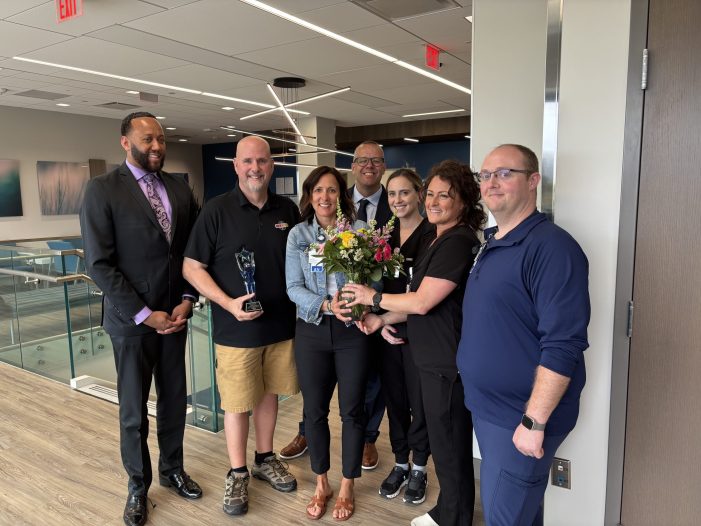‘Time is brain’ McLaren Oxford medical team says
By Jim Newell
Managing Editor
jnewell@mihomepaper.com
OXFORD — The actions of North Oakland Transportation Authority (NOTA) driver John Comparoni helped save the life of the woman he was driving home from a doctor’s appointment – a woman who began actively having a stroke.
The McLaren Oxford Emergency Department staff that cared for the patient recognized Comparoni’s actions with a Community Health Care Hero Award on May 14 “in recognition of his humanitarian spirit and swift actions in a medical emergency.”
On March 20, Comparoni, was transporting Lindalee (last name withheld for patient confidentiality) back to her home in Lake Orion from her scheduled appointment at McLaren Oxford, just four miles away.
Comparoni had taken Lindalee to the medical facility earlier in the day for a cardiac rehabilitation appointment. Halfway through the ride home, he began noticing changes in Lindalee’s speech, movement and mental status.
“I was calling out her name and she didn’t respond,” Comparoni said. “She was nonresponsive at that point. She couldn’t talk at all. I yelled her name several times and didn’t get a response. Her face kind of drooped. That’s when I knew something was wrong.”
Comparoni knew then that he had to take Lindalee back to the hospital quickly and notified NOTA dispatch that he was heading back to the hospital.
Nurse Jaclyn Eldridge said the emergency department was notified that they had a possible stroke patient outside.
“So, I ran out with a wheelchair to the NOTA bus and started doing a quick assessment that we always do on our stroke patients – whether or not she could tell me her name, where she was at,” Eldridge said. “She was having difficulty speaking, she was slumped over to the right, she couldn’t move her right side.”
Eldridge called for assistance and the McLaren team of Eldridge, nurses Jennie Kamin and Cody Medlock and Dr. Kathleen Stipek went into action and activated their stroke protocols.
“We want to make everything superfast because time is brain,” Eldridge said.
“It’s a whole teamwork thing. Everybody’s got their own thing to do: someone’s starting an IV, others are getting our Stroke Bot that we use in the room. So, it really is teamwork,” said Kamin.
Stroke robots are used in stroke care for diagnosis, treatment and rehabilitation. They allow remote specialists to assess and treat patients or assist in rehabilitation efforts.
Dr. Stipek was on duty in the emergency department and said she could tell right away that Lindalee was experiencing a stroke.
“She essentially had total right-side deficits; she couldn’t speak with us. She was really struggling with trying to communicate. We were not able to get her to help lift her out of her wheelchair at all. So, definitely signs of a stroke,” Stipek said. “So essentially between the weakness, the facial drooping and the inability to speak that’s almost like a classic major stroke.”
Treatment began immediately, which included a medication to dissolve the stroke-causing clot after a virtual conference with a stroke-trained interventional neurologist at McLaren Flint.
Lindalee’s condition was serious enough to also require a minimally invasive procedure to remove the clot from her brain’s blood vessels, which was completed at McLaren Flint.
Lindalee returned home a couple of days later.
“It was great on (Comparoni’s) part that he noticed something right away, that he was able to turn right back around. Great instincts on his part,” Kamin said.
Comparoni praised the medical team at McLaren Oxford for their swift treatment
“They went right to work and took care of her,” Comparoni said. “They said that everything we all did, it saved her life. That’s the main thing right there, she’s alive. I was in the right place at the right time. It was the Lord’s work, no doubt about it.”
May is National Stroke Awareness Month, a month dedicated to raising awareness of the prevalence of strokes and recognition of its symptoms. Strokes are the fourth leading cause of death in the United States, and are also the leading cause of adult disability. Delays in treatment and extending the time of disrupted blood flow in the brain leads to brain damage.
The McLaren team said that people in general should know the signs of a stroke because “time is brain” and the quicker a patient can receive treatment is crucial. An acronym people can use to help identify the signs of a possible stroke if BE FAST:
Balance loss,
Eyesight changes (blurred, double, or loss of vision),
Face drooping or numbness on one side,
Arm weakness or numbness,
Speech difficulty (slurred, garbled or unable to speak),
Time: call 911 immediately.
“Essentially, time is brain. Every second that goes by there’s a higher risk of losing blood flow, of losing circulation to that area of the brain that supports a particular function. So, you want to be able to identify the area where a stroke is occurring as soon as possible so that it’s safe to treat and we can restore that function,” Stipek said.
McLaren Oakland President and CEO Lorenzo Suter said Comparoni and the doctors and nurses are “remarkable people saving lives in this community.”
“John did amazing. I understand that (Lindalee) had pretty good restoration of the deficits that she was experiencing because he acted so quickly,” Stipek said. “I’m really glad that he was able to get the recognition that he did. Whoever is out in the field – a family member, a friend, whoever is taking care of the patient – they are the ones seeing things happen in real time.”


Leave a Reply